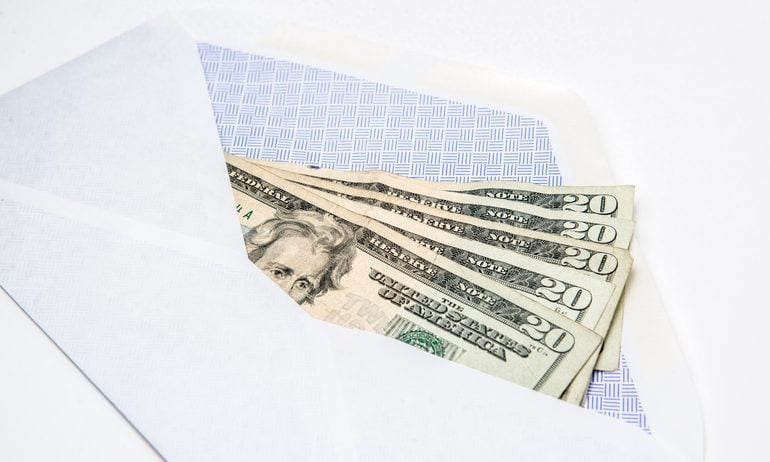What to Consider Before Budgeting With the Cash-Stuffing Method
The cash-stuffing method of budgeting revives the popularity on an old concept.

Many, or all, of the products featured on this page are from our advertising partners who compensate us when you take certain actions on our website or click to take an action on their website. However, this does not influence our evaluations. Our opinions are our own. Here is a list of our partners and here's how we make money.
When Giovanna “Gigi” Gonzalez wanted to cut back on her food spending, the finance expert and money coach applied what is known as the “cash-stuffing” method of budgeting. She put the cash she allotted to food for the week into an envelope and limited her spending to that amount.
“I could see when I had just 20 bucks left for the week, so it was really helpful,” she says.
Popularized through TikTok videos, cash stuffing has brought back the old-fashioned envelope system of budgeting: You divide up your cash into different envelopes, each dedicated to a category of spending or saving. “It’s a tried and true method,” says Gonzalez, who also founded The First Gen Mentor, a money course where she promotes financial literacy.
If you’re considering joining the cash-stuffing movement yourself, here are some guideposts:
Set aside planning time
Cash stuffing requires an upfront time commitment because you need to plan your spending, withdraw your cash and then “stuff” it into labeled envelopes. That process could easily take an hour or two to get prepared for the week ahead.
“It’s an additional time commitment,” Gonzalez acknowledges, but the upside is that “you immediately feel more in control of your money.”
Keep your cash safe
With so much cash on hand, it’s important to secure it, says Bruce McClary, senior vice president of membership and communications at the National Foundation for Credit Counseling. “There are all kinds of risks involved if you’re stuffing cash in places where you might forget it or heaven forbid something happens and the cash burns,” he says.
Tim Melia, a certified financial planner and founder at Embolden Financial Planning in Seattle, suggests keeping the cash envelopes in a fireproof safe that locks. He adds that while news about bank collapses likely contributed to the appeal of cash, an FDIC-insured bank account is still the safest place to store money. (The Federal Deposit Insurance Corp. insures up to $250,000 per depositor, per bank and per ownership category.)
Consider a hybrid approach
Gonzalez likes the idea of cash stuffing for everyday expenses but then moving larger amounts for savings or something like a house down payment into a bank account. “I don’t want that money sitting in an envelope,” she says. Also, cash doesn’t earn interest, but if you move the money into a high-yield bank account, it can grow.
Melia says cash stuffing is a great way to get started with budgeting and see where your money is going for a month or so. “Then, transition to a spreadsheet and bank account,” he recommends, noting that the discipline of the cash-stuffing method can stick with you.
McClary points out that many banks allow you to create digital envelopes for different categories in the form of separate bank accounts. For example, you might have labeled accounts for travel savings, down payment funds and everyday expenses, as well as a “fun money” account.
“The money is still deposited with a financial institution and insured through the FDIC, but you are able to accomplish this kind of envelope approach and segment it into different spending categories,” McClary says.
Severine Bryan, a personal finance educator and accredited financial counselor candidate, uses an approach she calls “faux cash stuffing” because she doesn’t carry the bills around. Instead, she assigns set dollar amounts to different categories like food and transportation, makes sure not to exceed those dollar amounts, and uses her credit card to earn cash back while she spends.
“I’m not using cash, but it’s the same idea,” she says.
Decide whether it’s a good fit
For some fans of the cash-stuffing method, the appeal comes down to the fact that you’re touching real cash. “It feels more real and you’re more aware of your spending, whereas if you’re swiping a credit or debit card, or buying something on Amazon, it doesn’t feel real. It’s just the click of a button,” Gonzalez says.
McClary notes that others are drawn to the simplicity of the method. “It’s not overly complicated and you are less likely to end up in debt because it keeps you spending within your means.”
Bryan says that cash stuffing likely works best for people who are more visual. “If you don’t want the friction of writing numbers down, this method becomes more fun with colorful envelopes. It doesn’t even feel like budgeting,” she says.
Skip the accessories
Even if you like the cash-stuffing method, you don’t need to purchase the accessories marketed by TikTok influencers, which include cute wallets and designer envelopes. Those extra expenditures could make for a rough start to budgeting, Melia warns.
All you need is a stack of envelopes and a pen to label them — and possibly a fireproof safe to keep all that cash secure.
This article was written by NerdWallet and was originally published by The Associated Press.

